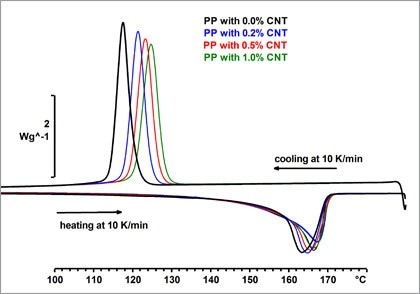
Understanding polymer crystallization is essential for improving production processes, optimizing material properties, developing new materials and failure analysis.
Polymer Crystallization
The crystallization process is initiated by a certain degree of cooling and begins with nucleation followed by growth. Heterogeneous nucleation is more common in polymers and can be accelerated by adding nucleation agents. Crystallization processes can be measured via non-isothermal crystallization, cold crystallization and isothermal crystallization.
Thermal Analysis Techniques for Investigating Polymer Crystallization
Thermal analysis techniques are ideal for the study of crystallization behaviors, vital to the optimization and processing of materials. DSC and Flash DSC in particular provide important insight into reorganization processes, whose study requires an extremely wide range of heating and cooling rates.
Differential scanning calorimetry (DSC) measures the heat flow produced in a sample when it is heated, cooled, or held isothermally at constant temperature. This technique is widely used to investigate exothermal events caused by crystallization or endothermal melting processes.
Flash DSC is a special type of DSC designed for the investigation of such fast processes. With scanning rates in the order of several thousands of degrees per second, this technique is ideal for the study of crystallization under processing conditions.
Crystallization processes can also be investigated by thermomechanical analysis (TMA), which measures dimensional changes in materials. TMA necessitates that volume changes are also measured to estimate the percentage of crystallinity.
Dynamic mechanical analysis (DMA) measures changes in sample stiffness, mechanical moduli and viscosity. DMA is a sensitive technique for detecting crystallization processes, where crystal formation leads to an increase in the storage modulus. However, the modulus change is not proportional to the degree of crystallinity.
Finally, hot stage microscopy is employed for kinetic investigations and the direct measurement of nucleation mechanisms, rate, and crystal growth.